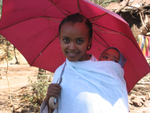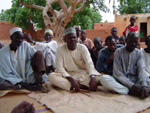Basic Steps to Develop Health Education Materials
Assess
What is the current problem or situation facing the target population? Is it trichiasis, active trachoma, or both?
Research
Conduct surveys and other research to measure the magnitude of the problem.
Plan
What is your communication strategy? How will health education be incorporated into your trachoma control program?
Draft
Produce rough drafts of the health education materials, incorporating the information gathered from the research and assessment steps. For each material produced, make three to five different drafts. Allow the target audience to choose the best.
Pre-test Pre-test the draft materials with focus groups representative of the target audience. Only after you are sure of the product, produce it. Modify the materials according to the results of the pre-test. Pre-test the modified materials and repeat until the target audience is happy.
Train Train health workers and community volunteers in trachoma control and prevention. Teach them how to use the new materials as a tool for education.
Distribute Distribute the materials to the users.
Monitor and Evaluate Conduct regular supervision of people using the materials to monitor their effectiveness. Use this information for the development of future materials. Evaluate the effect of the program after a couple of years.
Share Findings Share findings with other partner organizations working in the region. Develop possible collaboration for future health education activities.
Empower Volunteers Solicit feedback and suggestions from village volunteers over the life of the program. Encourage them to use existing health education materials as guides for their own health lesson development.
Overview
By making the health education materials on these pages available to all, the library provides examples from which ministries of health and partner organizations can create their own context-specific tools. This tutorial is intended to assist program managers in developing education materials. Health communication interventions should be part of a strategy based on in-depth knowledge of the target group.
How do I use this library?
Health education materials in this library are divided into the following categories: flip charts, posters, primary school, storybooks, t-shirts and hats, manuals and technical resources, leaflets, and school based materials.
Should I use materials from this library in my own program?
Compare the examples provided, but do not to simply download these images for use. Consider the differences between country programs and contexts. Print and share these images with colleagues, and use them as a starting point to develop context-specific original materials.
How do I create my own health education materials?
1. Define the health problem: Who is affected? Where is the problem found? What beliefs, attitudes, and practices contribute to the problem? If you are able to answer these questions, you have just begun your initial assessment.
2. Identify the target audience: What group of people are you trying to reach? Single men? Old women? Children? Mothers?
3. Identify the knowledge, attitudes, and practices of the target audience: Where do they live? What language do they speak? What work do they do? What do they believe? Consider behaviors that lead to the transmission of trachoma.
4. Identify behaviors that would help control trachoma in this population.
5. Determine what will influence your target audience. Can the audience read? Write? Do they listen to the radio? Do they travel to markets? Do they use health facilities? Do they have influential people in their communities such as religious leaders or government representatives?
6. Find out what the hopes and dreams of your target audience are. Incorporate peoples' dreams to reach and inspire them.
7. Develop a plan. Determine the behaviors that need to be promoted (latrine use, face-washing, etc.). Consider a communication strategy. Link the messages to behaviors, products, or services. Select a communication channel such as flip charts, posters, or leaflets.
8. Formative research may need to be conducted. This research involves a more in-depth analysis of the questions answered in the initial assessment. Consider what additional funding or technical support will be needed for this research. What research method should be used?
9.Use the research to develop draft materials. For example, if women in your area of intervention do not read, make flip charts that use clear pictures, not words. Use images that include scenes from the everyday life of your target audience. Make positive behaviors attractive and appealing.
10. Pre-test your draft materials. Visit intervention communities and hold health education sessions with different audiences to measure the community reaction. The more effective the health education material, the more likely community members will engage in discussion. Ask questions to measure the comprehension, appeal, and impact of your materials.
11. Once pre-tested, determine how many copies of the material to produce, create a distribution plan, and develop a training plan to teach health workers how to use the new material. Consider the seasonal calendar of your audience. Avoid debuting new materials in busy seasons.
12. Monitor and evaluate. Make a plan to supervise health education activities using these materials. Visit health workers to discuss their successes and failures. Are the new materials effective? Have they begun to have a measurable impact on the behaviors sought to change? To answer these questions, conduct a follow-up KAP or prevalence survey to measure the effect of the materials on your target audience.
Please sign up below for important news about the work of The Carter Center and special event invitations.
What can be learned from the initial assessment of the audiences below? Example questions to get started:

A Young Mother
Is she literate?
Does she use the local health clinic?
Does she have access to a radio?
Does she have her own source of income?

Adult Men
Do they leave the village for seasonal labor?
Do they pay for their children to use the health clinic?
Do they own a latrine?
What language do they speak?
Do they listen to the radio? When?

A Young Girl
Does she attend school?
How many siblings does she have? Is she their primary caretaker?
Does she fetch water?
What would she like to be when she grows up?

Students
What language do they speak in school? What language do they speak at home?
How often do they have health education?
Is this a rural school or an urban school?